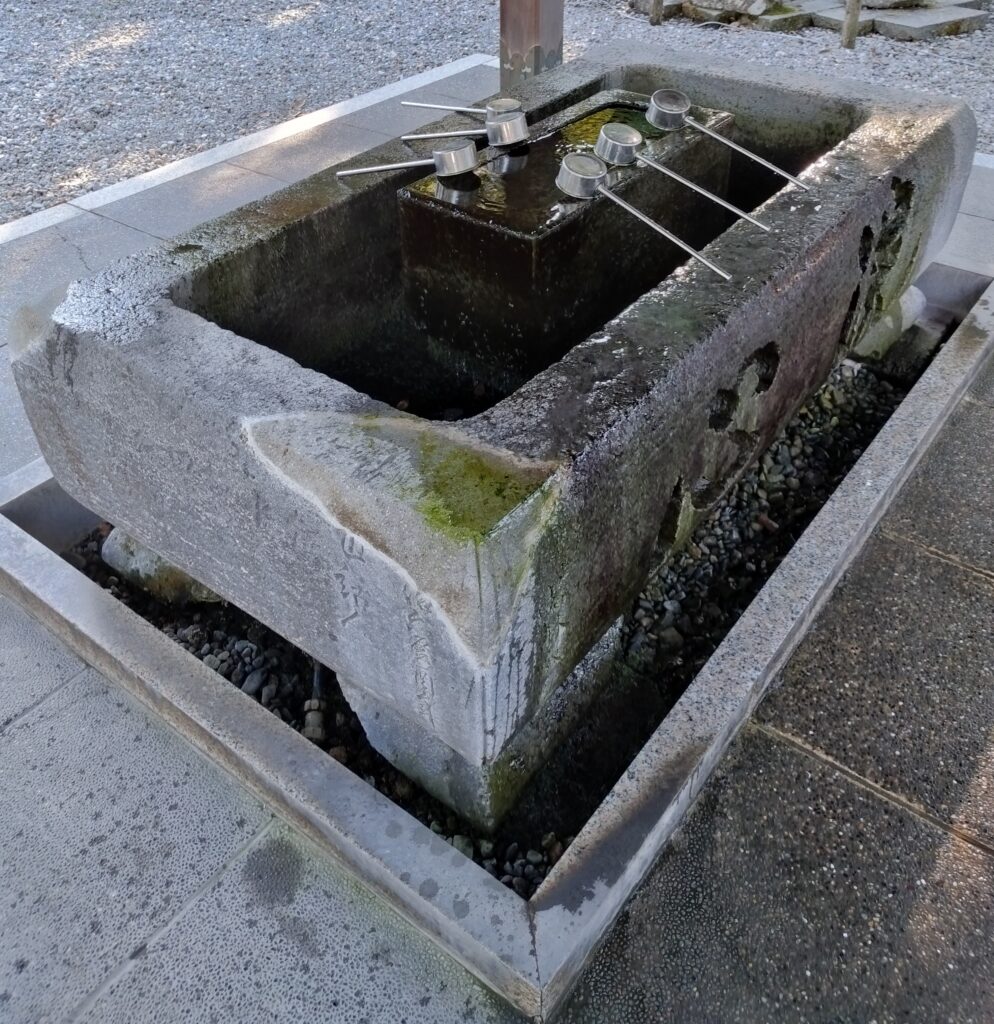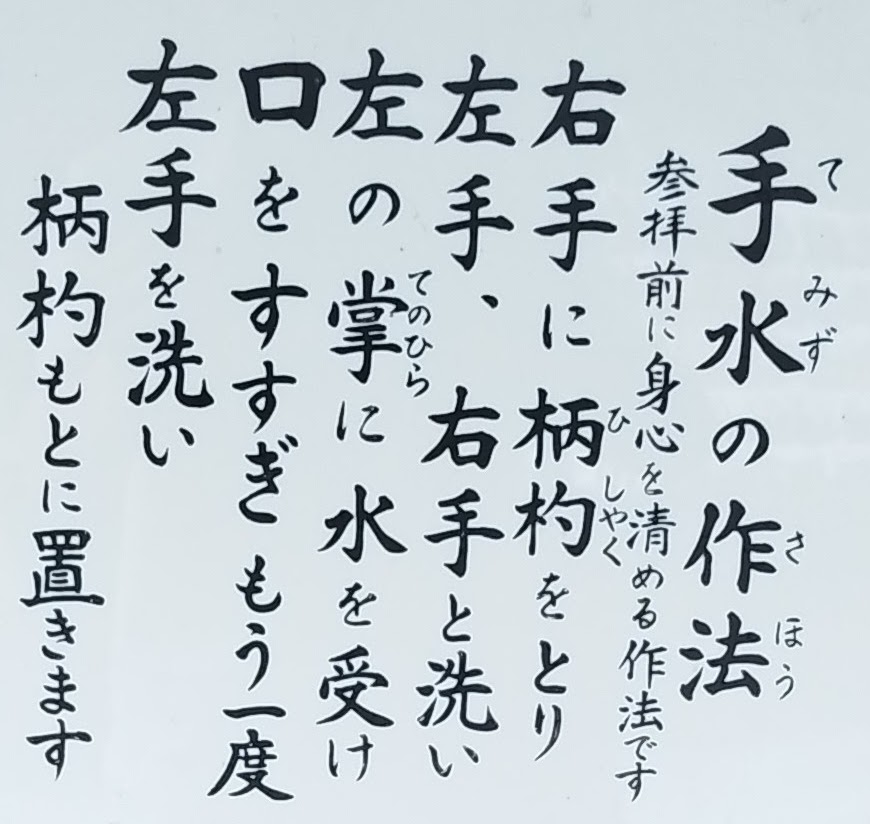本ブログではインバウンド(訪日外国人)ビジネスだけでなく企業接待や留学生対応等で英語説明が必要ながら多忙で情報収集に中々時間をかけられない方々の為にすぐに使える情報をわかりやすく解説しています。
今回は商談で訪日中の重要顧客から、市内移動中のタクシーの窓からチラッと見えた神社に「後で行ってみたい」と言われ、僅かの間にできるだけ的を得たご案内をしたいシチュエーションです。
今回テーマは神社案内時の下記手順に関する解説がメインですので、一般的知識や詳細情報は公式サイトや専門ブログ等をご参照下さい。また、いつも通り最後のパートに英語話者の音声サンプルを置きましたので、ご興味に合わせてご利用ください。👉本テーマには各ユニット(0~7)毎に演習ツールを別ブログで展開していますので、ご興味に合わせて各ユニットからご利用ください。
- 鳥居から入る♦Entering Through the Torii Gate
- 参道を歩く♦Walking Along the Shrine Approach
- 手水舎で清める♦Purifying Yourself at the Hand-Water Basin
- お参り&願い事をする♦Offering Prayers and Making Wishes
- おみくじを買う&占う♦Buying an Omikuji and Reading Your Fortune
- 絵馬を買う&願い事をする♦Buying an ema (votive tablet) & making a wish
- 鳥居を出る♦Exiting Through the Torii Gate
0.神社の作法について(ご参考)
本テーマではありませんので、具体的な作法に入る前にお相手にお伝えした方が良いと思われる点をご参考までにご紹介します。これも、ご自身のご経験や好みに合わせて、もし必要と思われるところあれば、適時お試し下さい。
👉本ユニットの練習用ツールは【0:事前心得編】英語説明演習ツールをご参照ください。
《日本語》
- 神社にお参りする際の厳格なルールや作法はありません。
- 参拝の作法も神社、地域、個人により異なります。
- 参拝作法を知らず、お参りだけする人も多いですが、日本の神様は寛大なので、何も心配はいりません。
- 多くの人が使っている一般的な礼拝作法として、今からご説明させていただきます。
- これから日本人の神様が住む特別な領域に入る事だけご認識いただければ幸いです。
《英訳例》
- There are no strict rules or etiquette for visiting shrines.
- The manner of worship can vary from shrine to shrine, region to region, and even among individuals.
- Many people visit the shrine without knowing the proper manners, but there’s no need to worry because Japanese gods are very forgiving.
- Let me now explain a general worship manner commonly used by many people
- We hope you understand that you are about to enter a sacred realm where the deities of the Japanese people reside.
1. 鳥居から入る
このパートも、目の前にある鳥居とお相手の動きやタイミングに合わせて、適時お試しください。
👉本ユニットの練習用ツールは【1.,鳥居2参道】英語説明演習ツールをご参照ください。
《日本語》
- 目の前のある二本の柱と上部の梁で繋がれた構造物は「鳥居」と言います。
- この鳥居は、教会に十字架が必ずあるように、どこの神社にも必ずあります。
- これは私たちが住む俗世と今から入る神の領域を区切る結界の意味があります。
- 入口の鳥居をくぐる前には、一旦止まり、会釈し、静かに境内に入ります。
- 鳥居がいくつも並んでいる場合、各鳥居の前で礼はできないので、通常は頭を少し低くして鳥居をくぐります。
《英訳例》
- The structure in front of you, connected by two pillars and a beam at the top, is called a ‘torii’ gate.
- A torii gate can be found in every shrine, just like you’d find a cross in a church.
- Its purpose is to symbolize the boundary between our everyday world and the divine realm we’re entering.
- Before passing through the torii gate, it’s customary to pause, offer a brief prayer, and then quietly enter the shrine grounds.
- If there are several torii gates in a row, it is common to walk through them with your head slightly lowered, as it would be impractical to bow at each gate.
2.参道を歩く
ここからは神の領域に入ったことをお伝えし、歩きながら日本人像について下記の様なコメントをすれば喜ばれるかもしれませんね。
👉本ユニットの練習用ツールは【1.,鳥居2参道】英語説明演習ツールをご参照ください。
《日本語》
- ここから先は神の領域なので、日本人は畏れを感じながら先に進みます。
- そのあらわれとして、多く人は参道の中央を避け左端を歩きます。
- 参道を横切るときは、頭を下げたり、正面に一礼する人もいます。
《英訳例》
- From this point onward, the Japanese advance with a sense of awe, for this is the domain of the gods.
- As a sign of this, many people avoid walking in the center of the approach and instead walk on the left side.
- When crossing the approach, some people bow their heads or bow in front of the shrine.
3.手水舎(ちょうずや)で清める
日本人でも不慣れな人だと少し戸惑う、手水舎(ちょうずや)の作法ですが、逆に多くのインバウンドは結構楽しそうに清めます。いったい全体、日本人ってなんだ?アライグマか?って感じですかね。
👉本ユニットの練習用ツールは【3.手水舎】英語説明演習ツールをご参照ください。

3-1 事前ご説明
ここも、ご参考までに、作法前に確認する表現を付加します。
《日本語》
- ここは手水舎と言って、水で手と口をすすいで、身を清める所てす。
- 今から、私が実演をしますので、ご覧ください。
- もし、ご興味があれば、試してみてください。
- 気が乗らなければ、ただ見ているだけでも、フリだけでも結構です。
《英訳例》
- This is a place called “Chozuya,” where you rinse your hands and mouth with water to purify yourself.
- I am going to demonstrate now, so please watch.
- If you are interested, please give it a try.
- If you don’t feel like it, you can just watch or pretend.

3-2 手順ご説明
《日本語》
- 最初に左手を清めます。
- ここでは神様に祈る前に水で心身を清めることが主な目的です。
- 目の前の柄杓を右手で持ち、水をくみ、柄杓の水の四分の一ほど、左手に水をかけます。
- 第二に右手を清めます。
- 左手に柄杓を持ち替え、また四分の一ほど右手にかけます。
- 第三に口を清めます。
- 柄杓を右手に持ち替え、左手の手のひらに四分の一ほどの水を注ぎ、その水で口をすすぎます。 .
- 第四に柄杓の柄を清めます。
- 柄杓を両手で立てるように持ち、柄杓の中に残っていた水を持ち手部分に流します。
- 最後に右手で元の場所に戻します。
- ハンカチで口と手を拭いて一礼して参道に戻ります。
《英訳例》
- Begin by purifying your left hand.
- This ritual serves to cleanse both body and mind with water before offering prayers.
- Hold the ladle in your right hand, fill it with water, and gently pour approximately a quarter of the water onto your left hand.
- Next, purify your right hand.
- Transfer the ladle to your left hand and pour approximately a quarter of the water onto your right hand.
- Now, rinse your mouth.
- Hold the ladle with your right hand, pour a quarter of the water into your left palm, and use it to rinse your mouth
- Next, cleanse the handle of the ladle.
- Hold the ladle upright with both hands and allow the remaining water to flow down the handle.
- Lastly, return the ladle to its original position using your right hand.
- Afterwards, use a handkerchief to dry your mouth and hands, bow, and then proceed back to the approach.
4.お参り&願い事をする
参道を通って神前に進みます。
👉本ユニットの練習用ツールは【4.お参り&願い事をする】英語説明演習ツールをご参照ください。
《日本語》
- 神様への信心の印として賽銭箱にお賽銭を入れます。
- 目の前にある賽銭箱の間に立って一礼します。
- 今日は特別にご案内役が代表してお賽銭を入れます。
- 二拝、二拍手、一拝という作法で拝礼、御祈りをします。
- まず、深いお辞儀を二回繰り返します。
- 二番目に、両手を胸の前で合わせ、2回拍手を打ちます。
- それから、打った両手を合わせながら、心を込めて祈ります。
- 最後に両手下ろし、深いお辞儀をします。
- 拝礼が終わったら、会釈をして、神前から参道に退きます。
《英訳例》
- To show your faith, place your donation in the collection box.
- Stand between the donation boxes in front of you and bow.
- Today, I’ll make a special donation on your behalf.
- We perform two bows, two claps, and one final bow during our prayer.
- First, bow deeply twice.
- Next, clap your hands together in front of your chest twice.
- While keeping your hands together, pray with all your heart.
- Finally, finish with a deep bow.
- When you are done, step back and move away from there.
5.おみくじを買う&占う
もしおみくじが置いてあったら、また、お相手が興味を示したら、ご案内しましょう。もしお気に入りのセリフがあれば、おみくじ開きながら、雑談用にお試しください。
👉本ユニットの練習用ツールは【5.おみくじを買う&占う】英語説明演習ツールをご参照ください。
- おみくじがありますので、ご興味があれば引いてみましょうか?
- 巫女さんにお金を払っておみくじを引きます。
- おみくじを開いて読んで、この先の運勢を確認します。
- 日本人は先ほどの願い事に対する神様のお告げと解釈します。
- なので、入学試験の結果を待つようにドキドキします。
- 神のメッセージは基本的に大吉から大協まで5段階に分かれています。
- その他に、結婚運、商売、試験、恋愛、病気にもコメントがあります。
- 不満足な結果だと、よいメッセージが出るまで何度も買う人もいます。
- 良いメッセージだと持ち帰り、悪いと神社の木に結んで帰る人もいます。
- その習慣は神社や個人により様々ですので、お好きなようにしてください。
《英訳例》
- You can draw an omikuji (written oracle) if you’re interested.
- To get your omikuji, simply pay the miko (shrine maiden) and draw one.
- Open and read your omikuji to discover your future fortune.
- Japanese people interpret omikuji as a divine oracle related to their earlier wishes.
- It can be an exciting experience as you await the results, especially for entrance examinations.
- The messages from the gods are typically categorized into five levels, ranging from Daikichi (great blessing) to Daikyo (great curse).
- You may also find comments related to marriage luck, business, examinations, love, and health.
- If the results are disappointing, some individuals purchase omikuji repeatedly until they receive a favorable message.
- People often take home good omikuji messages and tie the bad ones to a tree at the shrine.
- Keep in mind that customs can vary between different shrines and individuals, so feel free to follow your preferences.
6.絵馬を買う&願い事をする
もし絵馬があり、また、お相手が興味を示したら、ご案内しましょう。もしお気に入りのセリフがあれば、絵馬を書きながら、雑談用にお試しください。
👉本ユニットの練習用ツールは【6.絵馬を買う&願い事をする】英語説明演習ツールをご参照ください。
6-1 事前ご説明
まず、絵馬の種類とその背景にある興味深い意味をお伝えしましょう。
《日本語》
- 絵馬の文字通りの意味は「馬の絵」です。
- 古代、人々は生きた馬を神へ奉納しました。
- しかし、やがてほとんどの人には無理なお話でした。
- やがて、馬の絵が描かれた木製の扁額を奉納するようになりました。
- 現在、絵馬には干支の動物や神社のシンボル、縁起の良いものなど、さまざまなデザインがあります。
《英語》
- The word ema literally means “picture of a horse.”
- In ancient times, people would dedicate live horses to the gods as offerings.
- However, as time went on, this became impractical for most people.
- Eventually, the tradition evolved into offering wooden plaques painted with images of horses instead—what we now know as ema.
- Today, ema come in many designs, including animals from the Chinese zodiac, shrine symbols, and various lucky motifs.
6-2 手順ご説明
絵馬の種類は、神社の規模や願い事の種類によって異なります。ここでは、さまざまな願い事を受け入れてくれる神社にお参りすることを想定しています。
- まず、絵馬の種類を見てみましょう。さまざまな願いや個人的な希望に合ったデザインがたくさんあります。
- あなたの意図に合致するものを選んでください。
- 社務所または所定の窓口で絵馬代を支払い、絵馬を受け取ります。
- そして、絵馬の裏に願い事や感謝のメッセージを丁寧に書きます。
- 絵馬が飾られている場所を見つけ、そこに自分の絵馬を神への捧げ物として飾ります。
- 絵馬をお土産に持ち帰りたい人は、我慢した方が良いですね。
- その代わり、記念写真を撮りましょう。そうすれば、あなたの願いが神々に届き、祈りが叶うかもしれませんので。
《英語》
- First, browse the selection of ema—there are many designs to match different wishes and personal hopes.
- Choose one that resonates with your intention.
- Pay for the ema at the shrine office or a designated counter, and receive it.
- Then, carefully write your wish or a message of gratitude on the back of the ema.
- Find the ema display area, and hang yours there as an offering to the deity—joining it with the hopes of others.
- If you’d like to take the ema home as a souvenir, it’s better to refrain.
- Instead, take a photo to remember it by—this way, your wish remains with the gods, and your prayer may come true.
7.鳥居を出る
最後に1と同じご説明をして、ご一緒に退去しましょう。大変お疲れ様でした!
8.英語話者♦音声サンプル
上記の各パート毎に異なった話者を置きました。また今回も量が多いので、各パート単位で1ファイル、各文間、1秒ポーズで纏めましたので、お好みに合わせてチョイスください。
0.神社の作法について(ご参考)
いつも通り、最初は定番となりました米国女性ゆっくりタイプです。
2)The manner of worship can vary from shrine to shrine, region to region, and even among individuals.
3)Many people visit the shrine without knowing the proper manners, but there’s no need to worry because Japanese gods are very forgiving.
4)Let me now explain a general worship manner commonly used by many people..
5)We hope you understand that you are about to enter a sacred realm where the deities of the Japanese people reside.
1. 鳥居から入る
この厳かな気分にふさわしい英国男性のおっとり神主タイプです。
2)A torii gate can be found in every shrine, just like you’d find a cross in a church.
3)Its purpose is to symbolize the boundary between our everyday world and the divine realm we’re entering.
4)Before passing through the torii gate, it’s customary to pause, offer a brief prayer, and then quietly enter the shrine grounds.
2.参道を歩く
久々のオーストラリア女性が、珍しく神妙な雰囲気で語ります。
2)As a sign of this, many people avoid walking in the center of the approach and instead walk on the left side.
3)When crossing the approach, some people bow their heads or bow in front of the shrine.
3.手水舎(ちょうずや)で清める
作法前の確認はオーストラリア男性が少しばかりぎこちなく、続く、長い作法ガイドは、少し舌っ足らず気味の米国女性が、懸命に訴える様に語ります。
3-1 事前ご説明
2)I am going to demonstrate now, so please watch.
3)If you are interested, please give it a try.
4)If you don’t feel like it, you can just watch or pretend.
3-2 手順のご説明
・This ritual serves to cleanse both body and mind with water before offering prayers.
・Hold the ladle in your right hand, fill it with water, and gently pour approximately a quarter of the water onto your left hand.
2)Next, purify your right hand.
・Transfer the ladle to your left hand and pour approximately a quarter of the water onto your right hand.
3)Now, rinse your mouth.
・Hold the ladle with your right hand, pour a quarter of the water into your left palm, and use it to rinse your mouth
4)Next, cleanse the handle of the ladle.
・Hold the ladle upright with both hands and allow the remaining water to flow down the handle.
5)Lastly, return the ladle to its original position using your right hand
・.Afterwards, use a handkerchief to dry your mouth and hands, bow, and then proceed back to the approach.
4.お参り&願い事をする
儀式に関する説明に英国話者は格調高く、とてもしっくりあうのですが、なぜか今回の彼女は次のお御籤が気になるにか、少しせっかちな印象です。
2)Stand between the donation boxes in front of you and bow.
・Today, I’ll make a special donation on your behalf.
3)We perform two bows, two claps, and one final bow during our prayer.
・First, bow deeply twice.
・Next, clap your hands together in front of your chest twice.
・While keeping your hands together, pray with all your heart.
・Finally, finish with a deep bow.
4)When you are done, step back and move away from there.
5.おみくじを買う&占う
ここも長いですが、ドキドキ感の伝わる米国女性が早口気味に一気に語りますので、あっという間と感じるかもしれませんね。
2)To get your omikuji, simply pay the miko (shrine maiden) and draw one.
3)Open and read your omikuji to discover your future fortune.
4)Japanese people interpret omikuji as a divine oracle related to their earlier wishes.
5)It can be an exciting experience as you await the results, especially for entrance examinations.
6)The messages from the gods are typically categorized into five levels, ranging from Daikichi (great blessing) to Daikyo (great curse).
7)You may also find comments related to marriage luck, business, examinations, love, and health.
8)If the results are disappointing, some individuals purchase omikuji repeatedly until they receive a favorable message.
9)People often take home good omikuji messages and tie the bad ones to a tree at the shrine.
10)Keep in mind that customs can vary between different shrines and individuals, so feel free to follow your preferences.
6.絵馬を買う&願い事をする
6-1 事前ご説明
2)In ancient times, people would dedicate live horses to the gods as offerings.
3)However, as time went on, this became impractical for most people.
4)Eventually, the tradition evolved into offering wooden plaques painted with images of horses instead—what we now know as ema.
5)Today, ema come in many designs, including animals from the Chinese zodiac, shrine symbols, and various lucky motifs.
6-2 手順ご説明
2)Choose one that resonates with your intention.
3)Pay for the ema at the shrine office or a designated counter, and receive it.
4)Then, carefully write your wish or a message of gratitude on the back of the ema.
5)Find the ema display area, and hang yours there as an offering to the deity—joining it with the hopes of others.
6)If you’d like to take the ema home as a souvenir, it’s better to refrain.
7)Instead, take a photo to remember it by—this way, your wish remains with the gods, and your prayer may come true.
御礼🔶あとがき
お忙しい中、今回も最後までご覧いただき大変ありがとうございました。今回テーマ含め今後も定期的にブラッシュアップして参りますので、引き続きご参照のほど宜しくお願い致します。🔶Gold💎R50912v.4b.4b.1a/+


